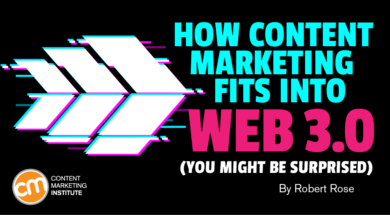 You can’t throw a rock these days and not hit a media site capitalizing on some primer on defining Web 3.0 (or Web3), NFTs, metaverses, and what it all means to marketers.
You can’t throw a rock these days and not hit a media site capitalizing on some primer on defining Web 3.0 (or Web3), NFTs, metaverses, and what it all means to marketers.
Go and read them. Most are pretty good. If you need some direction:
- AdAge has a great guide and a constantly updated list of brands using NFTs.
- Consultant and all-around smart guy Jeremiah Owyang has an excellent list and primer on NFTs and brand marketing.
- Joe Pulizzi and I did a recent podcast episode on Web 3.0 and what it means for marketing strategies.
- The Creative Show recently featured a primer and discussion about NFTs.
Spoiler alert: Web 3.0 has more kinship with content marketing than traditional brand and direct marketing and advertising. In fact, Web 3.0 may just be the evolution of content marketing.
Web 3.0 has more kinship with #ContentMarketing than traditional brand marketing and advertising, says @Robert_Rose via @CMIContent. #Web3 Click To TweetLet’s dig in a bit.
Evolution of a strategic marketing function: content to owned media to Web 3.0
In the earliest days of modern content marketing (2008-2009), Joe Pulizzi and I said that the content approach to marketing wasn’t new. It had just found its time.
The oldest content marketing examples include John Deere’s Furrow Magazine, Michelin Guides, and Benjamin Franklin’s Poor Richard’s Almanack, which promoted his printing business.
Most of these great examples were from brands looking to launch a new product or engage an existing customer base for loyalty. For example, looking at the history of content marketing, you’ll see so many customer loyalty magazines, employee engagement magazines, and content designed to teach customers how to use innovative products (Jell-O’s recipe book, for example).
In the early 2000s, content marketing evolved from side projects or campaigns to become a continuing and strategic business function. The trigger for this change was the expansion of the first disruptive Web 1.0 technology – web search.
The power of search engines forced product and services brands to become functionally competent at developing owned media properties. That enabled businesses and customers to circumvent traditional media and develop direct relationships.
I highlight that development because elements of Web 3.0 will prompt a similar trend.
Web 3.0 isn’t new – it’s just time
Early concepts of the metaverse date back to the early 2000s. The virtual Entropia Universe featured some of the first sales of digital property (what we call NFTs today). In 2009, a club in the Entropia Universe sold for more than $600,000 – the largest virtual world object ever sold at the time.
The marketing hype around virtual currencies goes back to 1999 with Beenz and Flooz (yes, those are real names). Beenz positioned itself as “the web’s currency.” The site paid people in “Beenz” for doing things such as viewing ads or signing up for a service. The company raised nearly $100 million and is considered one of the greatest dot-com disasters of all time.
Beenz launched around the same time as Flooz, a virtual currency startup (promoted by actress Whoopi Goldberg) that used its internet currency as a loyalty program to internet merchants.
Watching Flooz ads with Whoopi puts in perspective some of the current crypto platform commercials featuring Tom Brady and Matt Damon.
Web 3.0 concepts in the early 2020s are like content marketing concepts in the early 2000s. The ideas aren’t new, but they may transform into solid business strategies because technology has caught up enough to make these concepts useful.
Web 3.0 ideas aren’t new, but they may transform into solid business strategies because tech has caught up to make earlier concepts real, says @Robert_Rose via @CMIContent. #Web3 Click To TweetBut it’s very early. So, take the view many adopted in the early 2000s toward modern digital marketing, content, and SEO. Pay attention. Learn. Evolve. But know that nonsense abounds.
Web 3.0 opportunities for content marketers
We’re living through the earliest stages of a seismic transition in computing and virtualized digital connections. Web 3.0 technologies almost certainly will impact the way consumers experience, consume, transact, and behave.
The early promise of Web 3.0 echoes content marketing. Why? Web 3.0’s first iterations are about how people acquire and share content as a social signal, join virtual communities, and ultimately co-create valuable customer experiences.
In marketing, Web 3.0 may bring immersive participation and intelligent peer-to-peer transactions to the customer experience approach. It represents a potential power shift in allowing consumers to control their personal data.
Here’s what that means. As Web 3.0 technology emerges, you can start to envision how a consumer might use a digital wallet to store not just cryptocurrency but also personal information (name, email address, company, location, etc.). Consumers could share access to that data with any company they desire without handing over the actual data. And they could revoke that access any time they want.
In Web 3.0, envision how a customer might not hand over their personal information but give access to that data in their digital wallet, says @Robert_Rose via @CMIContent. #Web3 Click To TweetYour marketing database, then, would consist of dynamic access to tens of thousands of wallets rather than tens of thousands of static entries in a database. You’d retain the ability to target content experiences based on correct data because consumers would have every reason to keep their data current. However, the consumer also would be empowered to revoke that access (i.e., opt-out). Retaining the relationship would require delivering great value.
You can see how content-driven marketing experiences might evolve from paid, shared, and owned media platforms. In Web 3.0, the consumer (not the brand or marketer) controls the connection, which allows the relationship to extend across all the platforms they use.
How blockchain fits into content marketing
Blockchain technology enables these new decentralized capabilities for new customer experiences. It supports direct peer-to-peer transactions without a centralized service provider to facilitate them. You can already see this happening across the web:
- Decentralized finance decreases the requirement for banks.
- Decentralized commerce reduces the need for centralized cash register providers.
- Decentralized media networks decrease the dependence on social networks as virtual gathering points.
- Decentralized content, marketing, and advertising fundamentally change the digital relationship between customers and businesses.
I call this the “tokenized customer experience,” or “tokenized CX.”
Tokenized CX is just content marketing evolved
The mantra of marketing and customer experience is to “deliver the right message to the right person at the right time.” To know all three components typically requires businesses to track the consumer’s identity and their content behavior.
Marketers may soon be able to issue “tokens” (or smart contracts) powered by blockchain technology to enable more automated, secure, and trusted customer experiences.
These tokens can enable any transaction involving digital artifacts (including ads, downloadable assets, subscriptions, or access to communities). They empower consumers to help shape their experience and enable marketers to do that without surveillance-style efforts.
And they enable marketers to develop more creative content and marketing experiences. Brands such as Timberland and BMW have launched virtual worlds. Other brands have begun to create experiences within existing virtual worlds. For example, JP Morgan set up a virtual lounge within the Decentraland metaverse platform.
The kicker? In all these early entries, the scope is almost entirely a content marketing approach.
Timberland describes its virtual world as a “vibrant tour of the brand’s history via a mix of storytelling, art, music, and characters.” The company declares, “(T)his is not a game; it’s a story.”
The BMW virtual world is an education and thought leadership platform, creating an engaging way to learn about “electric mobility, urban mobility, and sustainability.” And the JP Morgan virtual lounge (for now) is simply a place to see presentations on the crypto economy.
Sound familiar? Each approach delivers a new content marketing experience.
Tomorrow’s content marketing and Web 3.0
These are the earliest days of Web 3.0 technology’s impact on the customer experience. Anyone who says they have it all figured out – whether they declare it the biggest scam or the biggest revolution – is likely wrong. No one knows.
In the Content Marketing Institute’s early years, I often said content marketing was still in the first inning. Web 3.0 is still in spring training.
The early days of Web 1.0 were all about pages, emails, blog posts, and downloads of documents through a browser. So marketers needed to focus on publishing content. Lots of content. Marketers needed to answer every customer question, provide a deep repository of knowledge, and make everything easy to find through commercial search engines.
Web 2.0 pushed marketers to create responsive (and contextual) approaches to delivering the right content throughout the customer journey. For the last 10 years, marketers have worked toward targeted one-to-one conversations and a 360-degree view of their audiences.
Along the way, data started to outshine content. The focus shifted from creating findable content to finding intent signals that let marketers anticipate needs and engage with people more effectively.
As data becomes more precious and content marketing becomes a more sophisticated business function, things are about to change again. How they’ll change remains a question.
Political, economic, environmental, and even social challenges may affect Web 3.0’s development.
But if it continues to develop along its current trajectory, expect a customer experience evolution based on tokenized CX. Empowered consumers will shape products or services as they interact with brand experiences. Marketers may develop a co-creation relationship with audience members and customers.
Put simply: Marketing in Web 1.0 helped customers FIND something better. Marketing in Web 2.0 helped customers EXPERIENCE something better. The promise of marketing in Web 3.0 is to help customers CREATE something better.
We’re not there yet. But pay attention. It will be an interesting ride.
Cover image by Joseph Kalinowski/Content Marketing Institute

